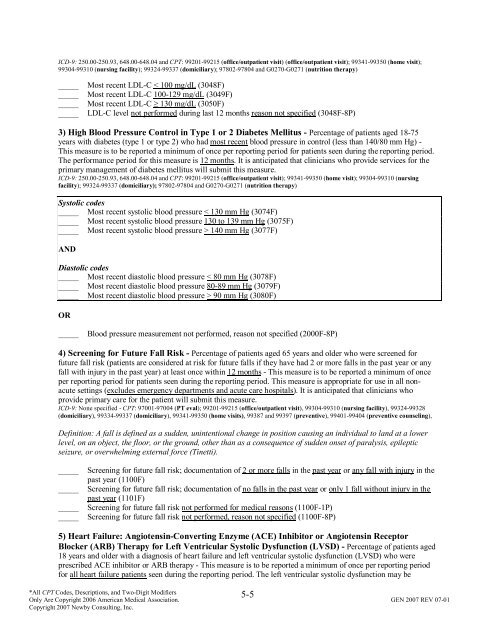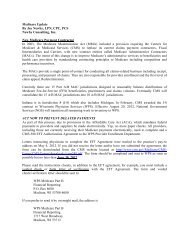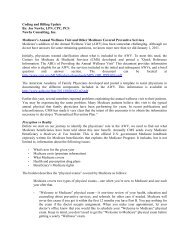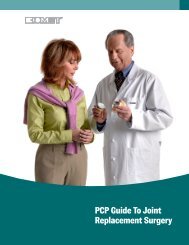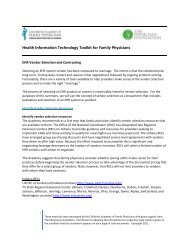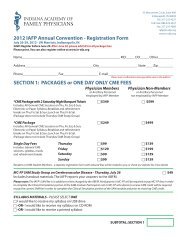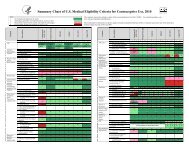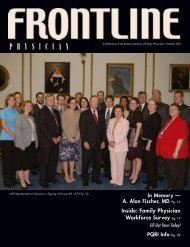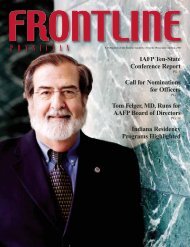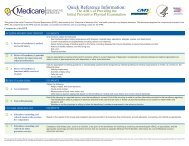pqri measure coding and reporting principles - Indiana Academy of ...
pqri measure coding and reporting principles - Indiana Academy of ...
pqri measure coding and reporting principles - Indiana Academy of ...
You also want an ePaper? Increase the reach of your titles
YUMPU automatically turns print PDFs into web optimized ePapers that Google loves.
ICD-9: 250.00-250.93, 648.00-648.04 <strong>and</strong> CPT: 99201-99215 (<strong>of</strong>fice/outpatient visit) (<strong>of</strong>fice/outpatient visit); 99341-99350 (home visit);<br />
99304-99310 (nursing facility); 99324-99337 (domiciliary); 97802-97804 <strong>and</strong> G0270-G0271 (nutrition therapy)<br />
_____<br />
_____<br />
_____<br />
_____<br />
Most recent LDL-C < 100 mg/dL (3048F)<br />
Most recent LDL-C 100-129 mg/dL (3049F)<br />
Most recent LDL-C ≥ 130 mg/dL (3050F)<br />
LDL-C level not performed during last 12 months reason not specified (3048F-8P)<br />
3) High Blood Pressure Control in Type 1 or 2 Diabetes Mellitus - Percentage <strong>of</strong> patients aged 18-75<br />
years with diabetes (type 1 or type 2) who had most recent blood pressure in control (less than 140/80 mm Hg) -<br />
This <strong>measure</strong> is to be reported a minimum <strong>of</strong> once per <strong>reporting</strong> period for patients seen during the <strong>reporting</strong> period.<br />
The performance period for this <strong>measure</strong> is 12 months. It is anticipated that clinicians who provide services for the<br />
primary management <strong>of</strong> diabetes mellitus will submit this <strong>measure</strong>.<br />
ICD-9: 250.00-250.93, 648.00-648.04 <strong>and</strong> CPT: 99201-99215 (<strong>of</strong>fice/outpatient visit); 99341-99350 (home visit); 99304-99310 (nursing<br />
facility); 99324-99337 (domiciliary); 97802-97804 <strong>and</strong> G0270-G0271 (nutrition therapy)<br />
Systolic codes<br />
_____ Most recent systolic blood pressure < 130 mm Hg (3074F)<br />
_____ Most recent systolic blood pressure 130 to 139 mm Hg (3075F)<br />
_____ Most recent systolic blood pressure > 140 mm Hg (3077F)<br />
AND<br />
Diastolic codes<br />
_____ Most recent diastolic blood pressure < 80 mm Hg (3078F)<br />
_____ Most recent diastolic blood pressure 80-89 mm Hg (3079F)<br />
_____ Most recent diastolic blood pressure > 90 mm Hg (3080F)<br />
OR<br />
_____<br />
Blood pressure <strong>measure</strong>ment not performed, reason not specified (2000F-8P)<br />
4) Screening for Future Fall Risk - Percentage <strong>of</strong> patients aged 65 years <strong>and</strong> older who were screened for<br />
future fall risk (patients are considered at risk for future falls if they have had 2 or more falls in the past year or any<br />
fall with injury in the past year) at least once within 12 months - This <strong>measure</strong> is to be reported a minimum <strong>of</strong> once<br />
per <strong>reporting</strong> period for patients seen during the <strong>reporting</strong> period. This <strong>measure</strong> is appropriate for use in all nonacute<br />
settings (excludes emergency departments <strong>and</strong> acute care hospitals). It is anticipated that clinicians who<br />
provide primary care for the patient will submit this <strong>measure</strong>.<br />
ICD-9: None specified - CPT: 97001-97004 (PT eval); 99201-99215 (<strong>of</strong>fice/outpatient visit), 99304-99310 (nursing facility), 99324-99328<br />
(domiciliary), 99334-99337 (domiciliary), 99341-99350 (home visits), 99387 <strong>and</strong> 99397 (preventive), 99401-99404 (preventive counseling),<br />
Definition: A fall is defined as a sudden, unintentional change in position causing an individual to l<strong>and</strong> at a lower<br />
level, on an object, the floor, or the ground, other than as a consequence <strong>of</strong> sudden onset <strong>of</strong> paralysis, epileptic<br />
seizure, or overwhelming external force (Tinetti).<br />
_____<br />
_____<br />
_____<br />
_____<br />
Screening for future fall risk; documentation <strong>of</strong> 2 or more falls in the past year or any fall with injury in the<br />
past year (1100F)<br />
Screening for future fall risk; documentation <strong>of</strong> no falls in the past year or only 1 fall without injury in the<br />
past year (1101F)<br />
Screening for future fall risk not performed for medical reasons (1100F-1P)<br />
Screening for future fall risk not performed, reason not specified (1100F-8P)<br />
5) Heart Failure: Angiotensin-Converting Enzyme (ACE) Inhibitor or Angiotensin Receptor<br />
Blocker (ARB) Therapy for Left Ventricular Systolic Dysfunction (LVSD) - Percentage <strong>of</strong> patients aged<br />
18 years <strong>and</strong> older with a diagnosis <strong>of</strong> heart failure <strong>and</strong> left ventricular systolic dysfunction (LVSD) who were<br />
prescribed ACE inhibitor or ARB therapy - This <strong>measure</strong> is to be reported a minimum <strong>of</strong> once per <strong>reporting</strong> period<br />
for all heart failure patients seen during the <strong>reporting</strong> period. The left ventricular systolic dysfunction may be<br />
*All CPT Codes, Descriptions, <strong>and</strong> Two-Digit Modifiers<br />
Only Are Copyright 2006 American Medical Association. GEN 2007 REV 07-01<br />
Copyright 2007 Newby Consulting, Inc.<br />
5-5


